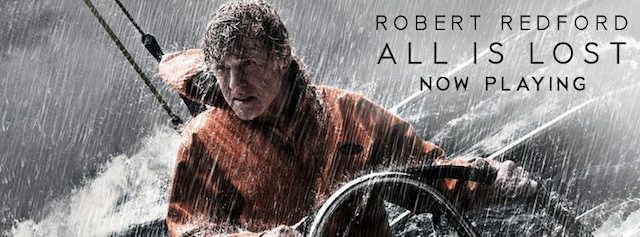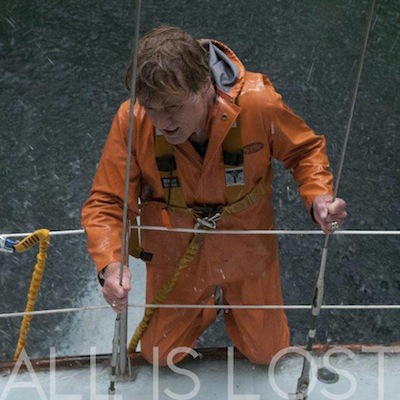'Gravity' Vs. 'All Is Lost'
By Scott Lucas in Arts & Entertainment on Nov 20, 2013 10:45PM

It's a slow movie week here in Chicago and across the country. With everyone seemingly hung over from the sugar rush of last week's Thor: The Dark World and awaiting their next fix of Katniss Whatever-Her-Name-Is on Friday (or Thursday night)—the studios saw fit to dole out just one major release this week and it's a Christmas movie; The Best Man Holiday. I've got nothing against Taye Diggs and Terrence Howard, but don't you think it's a little too early in the year for yuletide cinema? So, what to see? Matthew McConaughey is reliably great in Dallas Buyers Club. The emotionally devastating French lesbian drama, Blue Is The Warmest Color lives up to its hype as being pretty awesome. And if you're still not aware of how horrible slavery was, you can subject yourself to 12 Years A Slave.
Or you could do what all the kids are doing and go see Gravity again.
Yeah, sure—you could do that, but why not go see Gravity's thoroughly excellent doppelgänger, All Is Lost instead?
When I saw J.C. Chandor's All Is Lost a few weeks ago, I couldn't help thinking that the open water survival thriller with Robert Redford (as the film's sole character) seemed to function as an unintended rebuttal to the outer space survival thriller with Sandra Bullock (almost Gravity's sole character). Since both films were released at around the same time, this theory certainly doesn't hold up—but the similarities (and more importantly, the differences) between the two films are definitely striking. Both films center around a lone protagonist, adrift in a large seemingly insurmountable vastness, fighting for their lives with nothing but ingenuity, resilience and badly damaged vessels. But what each film does with that simple set up would seem to speak more about the ingenuity and resilience of the filmmakers (in Gravity's case, the very talented Alfonso Cuaron).
 Gravity, as we all know, takes place in outer space. All Is Lost is set on the Indian Ocean. In addition to Bullock, Gravity stars dreamy George Clooney and some other guy (Phaldut Sharma). In All Is Lost, the formerly dreamy Robert Redford is the only actor onscreen for the entire film. Gravity has all the expository dialogue you'd expect from this sort of movie and though it basically brings the movie screeching to a halt, all that exposition certainly tells us all we really (don't) need to know about Bullock's character and her life on Earth. In the most interesting and radical contrast between the two movies, we don't find out anything about Redford's character in All Is Lost. We don't even learn his name. In fact, aside from an offscreen Redford reading a farewell letter in the film's prologue, and a well earned "FUCK!" about halfway through—there's not a word of dialogue (maybe a "HELP!" or two?). Not to worry. Redford sells it like a champ (he's really amazing in this movie) and Chandor's decision to jettison all that needless backstory enables him to focus our attention on his character's increasingly dire situation. It's as economical and direct as a Hemingway short story.
Gravity, as we all know, takes place in outer space. All Is Lost is set on the Indian Ocean. In addition to Bullock, Gravity stars dreamy George Clooney and some other guy (Phaldut Sharma). In All Is Lost, the formerly dreamy Robert Redford is the only actor onscreen for the entire film. Gravity has all the expository dialogue you'd expect from this sort of movie and though it basically brings the movie screeching to a halt, all that exposition certainly tells us all we really (don't) need to know about Bullock's character and her life on Earth. In the most interesting and radical contrast between the two movies, we don't find out anything about Redford's character in All Is Lost. We don't even learn his name. In fact, aside from an offscreen Redford reading a farewell letter in the film's prologue, and a well earned "FUCK!" about halfway through—there's not a word of dialogue (maybe a "HELP!" or two?). Not to worry. Redford sells it like a champ (he's really amazing in this movie) and Chandor's decision to jettison all that needless backstory enables him to focus our attention on his character's increasingly dire situation. It's as economical and direct as a Hemingway short story.
And then there's the special effects. Gravity has the finest visual effects that money can buy. And make no mistake—they are truly awesome. But I honestly don't remember feeling for one minute that Bullock was in any danger, and for a genre predicated on the threat of bodily harm to its characters, that's a big problem. Maybe it's because I've never been to outer space. Or maybe it's because I knew that nothing onscreen was real. Not even their spacesuits, apparently. It was all digital rendering. I don't know about you, but when nothing is real or feels real, I have a hard time getting worked up. In All Is Lost, however, I couldn't STOP worrying about Redford. At one point he climbs to the top of the ship's mast and I was, for real, fucking freaking out that he was going to fall. Ten minutes later I thought he was gonna drown. I couldn't figure out how they were doing all these things to him without killing him. He's 77, for Christ's sake! Take it easy on the guy! Nothing is rendered here. What wasn't shot in a real ocean (with real sharks) was staged in the water tanks where they shot Titanic. The constant presence of a physical and tactile "reality" is key to making us putty in Chandor's hands.
Of course, it's certainly possible that All Is Lost was conceived as a direct response to the fancies of last year's Life Of Pi—another movie about a sole survivor adrift at sea—but that film had it's own corrective doppelgänger in the excellent Liam Neeson vehicle The Grey (Tropical heat vs. arctic cold. 3-D technicolor seas vs. monochromatic snow. A young boy vs. hardened men. An anthropomorphized tiger vs. heartless, ghostly wolves. A character who tell us his story will make us "believe in God" vs. a Liam Neeson who searches the empty, overcast skies for an agonizing moment before barking, "Fuck it. I'll do it myself."). But it's Gravity and All Is Lost's single-minded focus on the mechanics of battling each film's version of a great big NOTHING that makes them the ideal survival-movie double-feature. Maybe the real difference comes down to budget—Gravity cost about 100 million dollars while All Is Lost was made for 9 million. One film had seemingly endless resources while the other had to be resourceful. It's little wonder that one film seems to have a better grasp on those mechanics of survival than the other.